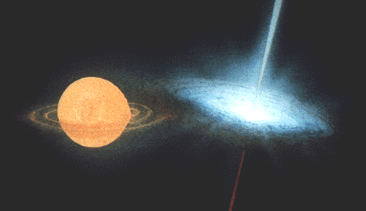What is the Structure and Behavior of Matter Under Extreme Conditions?
The Universe is filled with many cases where matter
has evolved to extreme physical conditions. Examples include
white dwarfs and
neutron stars where the
gravitational force of collapse is balanced by the quantum forces exerted by
electrons and nuclear matter. Or black holes where the force of gravity has won
out over all other forces and the mass density is so high that even light is
gravitationally bound. We can study these systems by the effects they have on
the matter around them. Often neutron stars and black holes found in
galaxies have binary companions that are so close that stellar material
is transferred to the compact star. Black holes are also highly likely
to be at the centers of most galaxies
and have huge accretion disks around them. As matter falls closer to the compact
object, it is heated to the such an extreme that X-rays are the primary form of
emission.

Artist's concept of SS433, one of the most exotic star systems known.
Its remarkable behavior stems from a compact object, a black hole or
neutron star, which has produced an accretion disk with jets. |
The X-ray emission is then the carrier of information that offers clues to the
underlying collapsed object. So far this emission has provided a number of
probes into the structure of the matter in the vicinity of these singular
objects:
- highly coherent X-ray and radio pulsed signals
- X-ray bursts
- both high and low frequency quasiperiodic oscillations
- aperiodic variability
- unique spectral signatures
From these probes we can hope to address such questions as:
- what is the equation of state of nuclear matter?
- how do neutron stars cool and how long does it take?
- what is the structure of neutron star atmospheres undergoing accretion from
the interstellar medium and from binary companions?
- how do neutron stars lose their magnetic fields?
- what is the structure of neutron star magnetospheres?
- how does electromagnetic radiation and matter come into equilibrium in very
high gravitational and magnetic fields that are up to a trillion times greater
than encountered here on Earth?
- are galactic compact stellar objects with masses greater than 3 solar
masses really black holes?
- what is the structure of matter around black holes?
|
